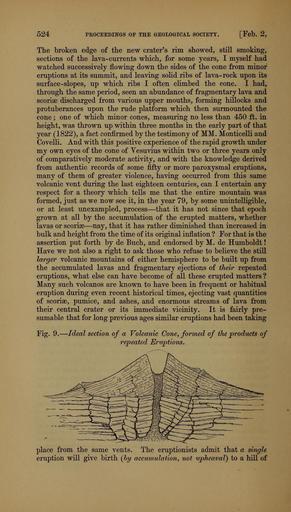MAKE A MEME
View Large Image

| View Original: | The_Quarterly_journal_of_the_Geological_Society_of_London_(12981206593).jpg (1162x2045) | |||
| Download: | Original | Medium | Small | Thumb |
| Courtesy of: | commons.wikimedia.org | More Like This | ||
| Keywords: The Quarterly journal of the Geological Society of London (12981206593).jpg 524 <br> PROCEEDINGS OP THE GEOLOGICAL SOCIETY Feb 2 <br> The broken edge of the new crater's rim showed still smoking <br> sections of the lava- currents which for some years I myself had <br> watched successively flowing down the sides of the cone from minor <br> eruptions at its summit and leaving soHd ribs of lava- rock upon its <br> surface-slopes up which ribs I often cHmbed the cone I had <br> through the same period seen an abundance of fragmentary lava and <br> scoriae discharged from various upper mouths forming hillocks and <br> protuberances upon the rude platform which then surmounted the <br> cone ; one of which minor cones measuring no less than 450 ft in <br> height was thrown up within three months in the early part of that <br> year 1822 a fact confirmed by the testimony of MM Monticelli and <br> Covelli And with this positive experience of the rapid growth under <br> my own eyes of the cone of Vesuvius within two or three years only <br> of comparatively moderate activity and with the knowledge derived <br> from authentic records of some fifty or more paroxysmal eruptions <br> many of them of greater violence having occurred from this same <br> volcanic vent during the last eighteen centuries can I entertain any <br> respect for a theory which tells me that the entire mountain was <br> formed just as we now see it in the year 79 by some unintelligible <br> or at least unexampled process ” that it has not since that epoch <br> grown at all by the accumulation of the erupted matters whether <br> lavas or scoriae ” nay that it has rather diminished than increased in <br> bulk and height from the time of its original inflation Eor that is the <br> assertion put forth by de Buch and endorsed by M de Humboldt <br> Have we not also a right to ask those who refuse to believe the still <br> larger volcanic mountains of either hemisphere to be built up from <br> the accumulated lavas and fragmentary ejections of their repeated <br> eruptions what else can have become of all these erupted matters <br> Many such volcanos are known to have been in frequent or habitual <br> eruption during even recent historical times ejecting vast quantities <br> of scoriae pumice and ashes and enormous streams of lava from <br> their central crater or its immediate vicinity It is fairly pre- <br> sumable that for long previous ages similar eruptions had been taking <br> Eig 9 ” Ideal section of a Volcanic Cone formed of the products of <br> repeated Eruptions <br> place from the same vents The eruptionists admit that a single <br> eruption will give birth by accumulation not upheaval to a hill of 36162091 111474 51125 Page 524 Text v 15 http //www biodiversitylibrary org/page/36162091 1859 Geological Society of London NameFound Vesuvius Biodiversity Heritage Library The Quarterly journal of the Geological Society of London v 15 1859 Geology Periodicals Smithsonian Libraries bhl page 36162091 dc identifier http //biodiversitylibrary org/page/36162091 smithsonian libraries Information field Flickr posted date ISOdate 2014-03-07 Check categories 2015 August 26 CC-BY-2 0 BioDivLibrary https //flickr com/photos/61021753 N02/12981206593 2015-08-26 14 56 52 cc-by-2 0 PD-old-70-1923 The Quarterly journal of the Geological Society of London 1859 Photos uploaded from Flickr by Fæ using a script | ||||